sensor TOYOTA COROLLA 2022 (in English) Service Manual
[x] Cancel search | Manufacturer: TOYOTA, Model Year: 2022, Model line: COROLLA, Model: TOYOTA COROLLA 2022Pages: 678, PDF Size: 147.24 MB
Page 264 of 678
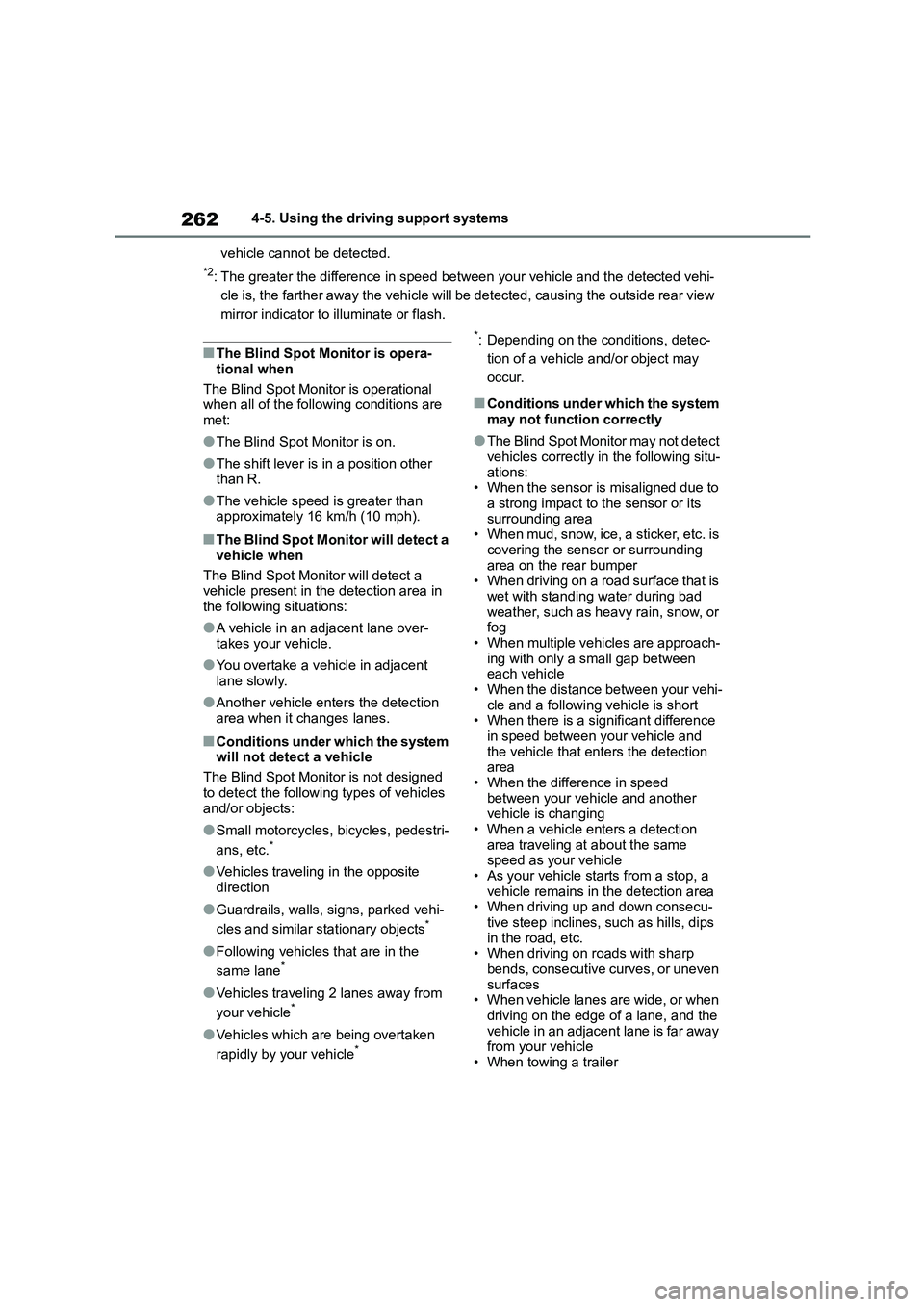
2624-5. Using the driving support systems
vehicle cannot be detected.
*2: The greater the difference in speed between your vehicle and the detected vehi-
cle is, the farther away the vehicle will be detected, causing the outside rear view
mirror indicator to illuminate or flash.
■The Blind Spot Monitor is opera-
tional when
The Blind Spot Monitor is operational
when all of the following conditions are
met:
●The Blind Spot Monitor is on.
●The shift lever is in a position other
than R.
●The vehicle speed is greater than
approximately 16 km/h (10 mph).
■The Blind Spot Monitor will detect a
vehicle when
The Blind Spot Monitor will detect a
vehicle present in the detection area in
the following situations:
●A vehicle in an adjacent lane over-
takes your vehicle.
●You overtake a vehicle in adjacent
lane slowly.
●Another vehicle enters the detection
area when it changes lanes.
■Conditions under which the system will not detect a vehicle
The Blind Spot Monitor is not designed
to detect the following types of vehicles
and/or objects:
●Small motorcycles, bicycles, pedestri-
ans, etc.*
●Vehicles traveling in the opposite
direction
●Guardrails, walls, signs, parked vehi-
cles and similar stationary objects*
●Following vehicles that are in the
same lane*
●Vehicles traveling 2 lanes away from
your vehicle*
●Vehicles which are being overtaken
rapidly by your vehicle*
*: Depending on the conditions, detec-
tion of a vehicle and/or object may
occur.
■Conditions under which the system may not function correctly
●The Blind Spot Monitor may not detect vehicles correctly in the following situ-
ations:
• When the sensor is misaligned due to a strong impact to the sensor or its
surrounding area
• When mud, snow, ice, a sticker, etc. is covering the sensor or surrounding
area on the rear bumper
• When driving on a road surface that is wet with standing water during bad
weather, such as heavy rain, snow, or
fog • When multiple vehicles are approach-
ing with only a small gap between
each vehicle • When the distance between your vehi-
cle and a following vehicle is short
• When there is a significant difference in speed between your vehicle and
the vehicle that enters the detection
area • When the difference in speed
between your vehicle and another
vehicle is changing • When a vehicle enters a detection
area traveling at about the same
speed as your vehicle • As your vehicle starts from a stop, a
vehicle remains in the detection area
• When driving up and down consecu-
tive steep inclines, such as hills, dips in the road, etc.
• When driving on roads with sharp
bends, consecutive curves, or uneven surfaces
• When vehicle lanes are wide, or when
driving on the edge of a lane, and the vehicle in an adjacent lane is far away
from your vehicle
• When towing a trailer
Page 265 of 678
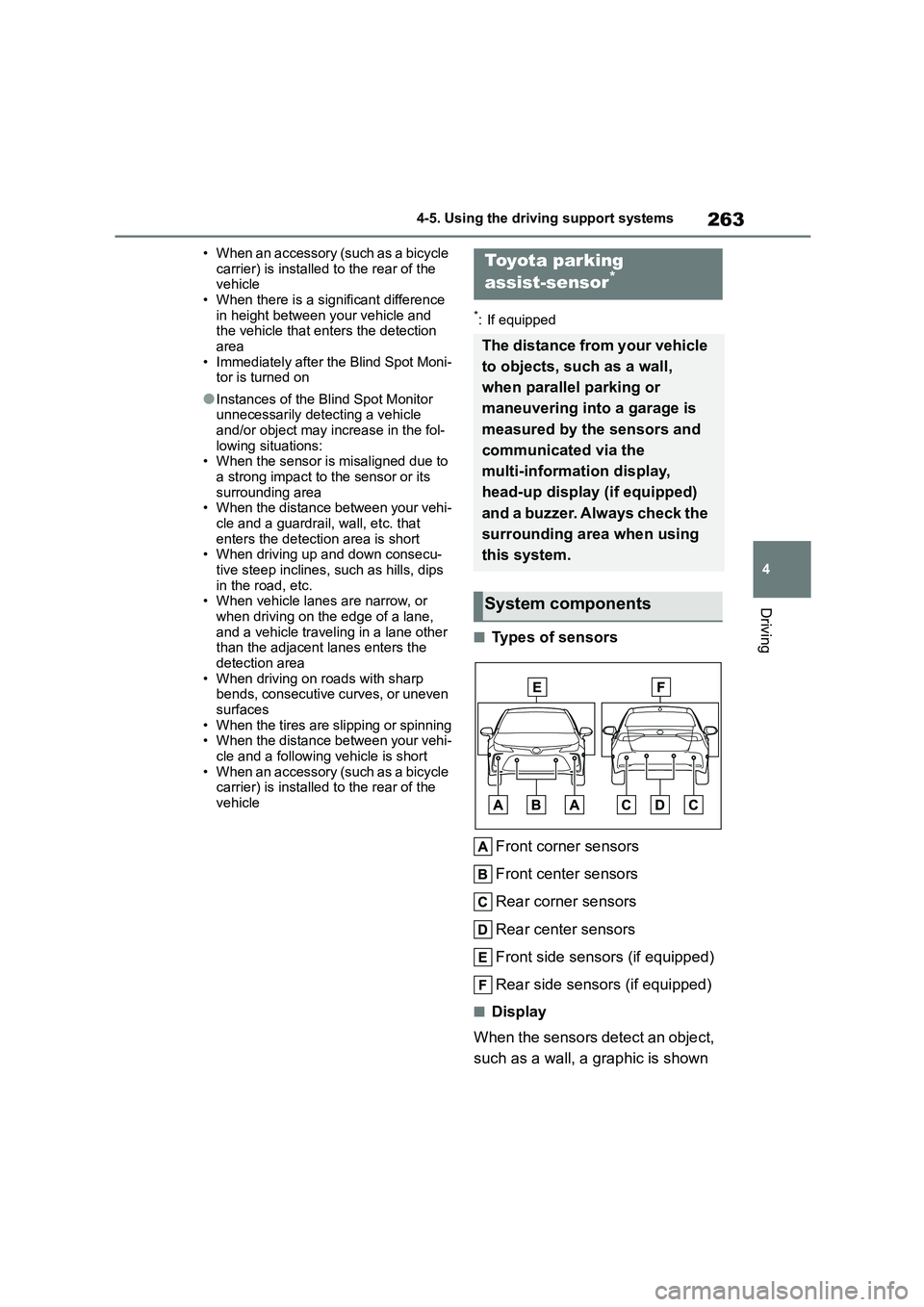
263
4
4-5. Using the driving support systems
Driving
• When an accessory (such as a bicycle
carrier) is installed to the rear of the vehicle
• When there is a significant difference
in height between your vehicle and the vehicle that enters the detection
area
• Immediately after the Blind Spot Moni- tor is turned on
●Instances of the Blind Spot Monitor unnecessarily detecting a vehicle
and/or object may increase in the fol-
lowing situations: • When the sensor is misaligned due to
a strong impact to the sensor or its
surrounding area • When the distance between your vehi-
cle and a guardrail, wall, etc. that
enters the detection area is short • When driving up and down consecu-
tive steep inclines, such as hills, dips
in the road, etc. • When vehicle lanes are narrow, or
when driving on the edge of a lane,
and a vehicle traveling in a lane other than the adjacent lanes enters the
detection area
• When driving on roads with sharp bends, consecutive curves, or uneven
surfaces
• When the tires are slipping or spinning • When the distance between your vehi-
cle and a following vehicle is short
• When an accessory (such as a bicycle carrier) is installed to the rear of the
vehicle
*: If equipped
■Types of sensors
Front corner sensors
Front center sensors
Rear corner sensors
Rear center sensors
Front side sensors (if equipped)
Rear side sensors (if equipped)
■Display
When the sensors detect an object,
such as a wall, a graphic is shown
Toyota parking
assist-sensor*
The distance from your vehicle
to objects, such as a wall,
when parallel parking or
maneuvering into a garage is
measured by the sensors and
communicated via the
multi-information display,
head-up display (if equipped)
and a buzzer. Always check the
surrounding area when using
this system.
System components
Page 266 of 678

2644-5. Using the driving support systems
on the multi-information display and
head-up display (if equipped)
depending on the position and dis-
tance to the object.
Multi-information display and
head-up display
Front corner sensor detection
Front center sensor detection
Front side sensor detection (if
equipped)*
Rear side sensor detection (if
equipped)*
Rear corner sensor detection
Rear center sensor detection
*: The side sensor displays are not
shown until a scan of the side areas
is completed.
Use the meter control switches to
enable/disable the Toyota parking
assist-sensor. ( P. 9 4 )
1 Press or to select .
2 Press or to select
and then press .
When the Toyota parking
assist-sensor function is disabled,
the Toyota parking assist-sensor
OFF indicator ( P.83) illuminates.
To re-enable the system when it
was disabled, select on the
multi-information di splay, select
and then on. If disabled using this
method, the sy stem will not be
re-enabled by turning the engine
switch off and then to ON.
Turning Toyota parking
assist-sensor on/off
WA R N I N G
■Cautions regarding the use of
the system
There is a limit to the degree of recog- nition accuracy and control perfor-
mance that this system can provide,
do not overly rely on this system. The driver is always responsible for paying
attention to the vehicle’ surroundings
and driving safely.
■To ensure the system can oper-
ate properly
Observe the following precau-
tions.Failing to do so may result in the
vehicle being unable to be driven safely and possibly cause an acci-
dent.
●Do not damage the sensors, and
always keep them clean.
●Do not attach a sti cker or install an
electronic component, such as a
backlit license plate (especially fluo- rescent type), fog lights, fender pole
or wireless antenna near a radar
sensor.
Page 267 of 678
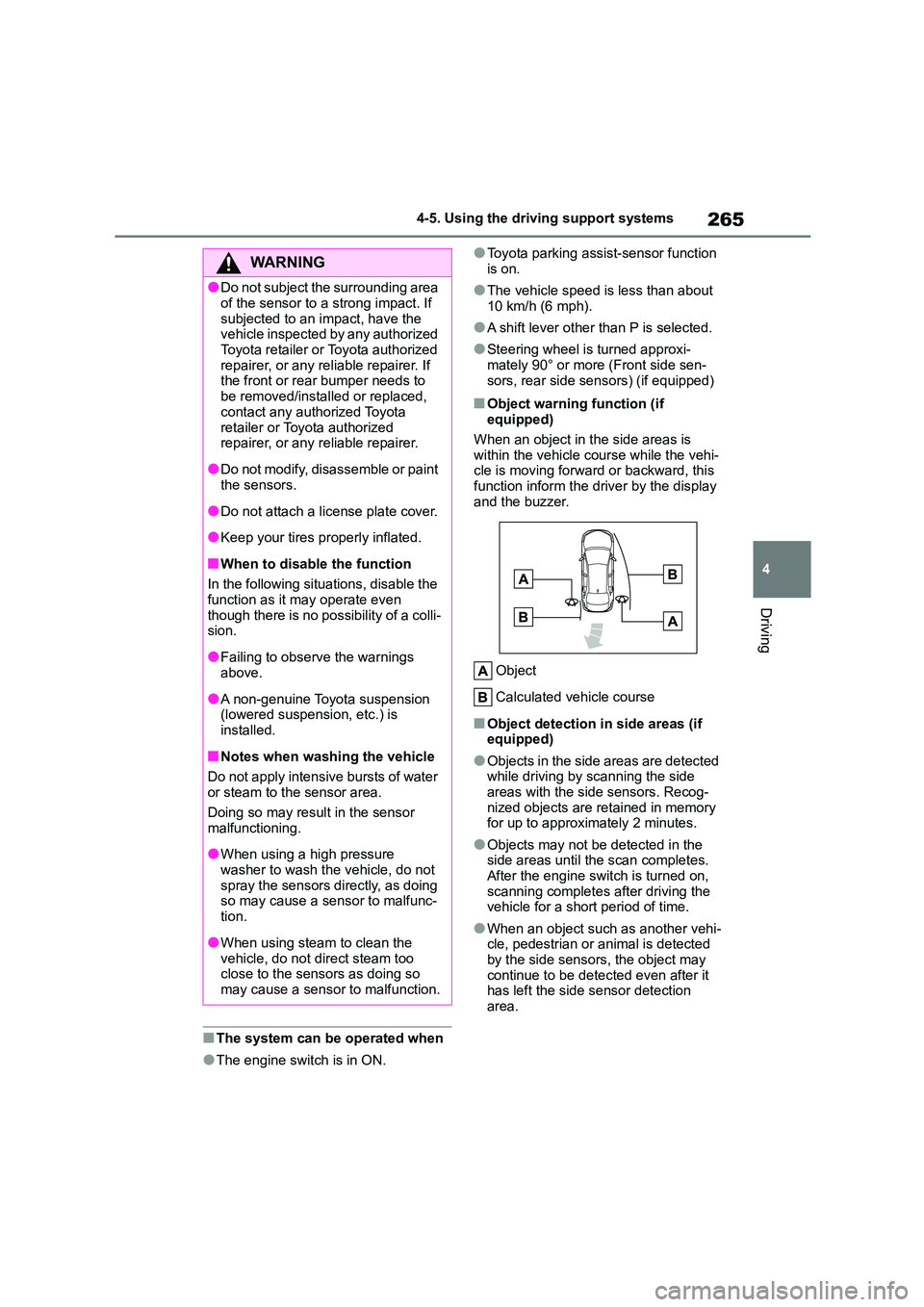
265
4
4-5. Using the driving support systems
Driving
■The system can be operated when
●The engine switch is in ON.
●Toyota parking assi st-sensor function
is on.
●The vehicle speed is less than about
10 km/h (6 mph).
●A shift lever other than P is selected.
●Steering wheel is turned approxi-
mately 90° or more (Front side sen-
sors, rear side sensors) (if equipped)
■Object warning function (if equipped)
When an object in the side areas is
within the vehicle co urse while the vehi- cle is moving forward or backward, this
function inform the driver by the display
and the buzzer.
Object
Calculated vehicle course
■Object detection in side areas (if equipped)
●Objects in the side areas are detected while driving by scanning the side
areas with the side sensors. Recog-
nized objects are retained in memory for up to approximately 2 minutes.
●Objects may not be detected in the side areas until the scan completes.
After the engine switch is turned on,
scanning completes after driving the vehicle for a short period of time.
●When an object such as another vehi-cle, pedestrian or animal is detected
by the side sensors, the object may
continue to be detected even after it has left the side sensor detection
area.
WA R N I N G
●Do not subject the surrounding area
of the sensor to a strong impact. If
subjected to an impact, have the vehicle inspected by any authorized
Toyota retailer or Toyota authorized
repairer, or any reliable repairer. If the front or rear bumper needs to
be removed/installed or replaced,
contact any authorized Toyota
retailer or Toyota authorized repairer, or any reliable repairer.
●Do not modify, disassemble or paint the sensors.
●Do not attach a license plate cover.
●Keep your tires properly inflated.
■When to disable the function
In the following situations, disable the
function as it may operate even though there is no possibility of a colli-
sion.
●Failing to observe the warnings
above.
●A non-genuine Toyota suspension
(lowered suspension, etc.) is
installed.
■Notes when washing the vehicle
Do not apply intensive bursts of water or steam to the sensor area.
Doing so may result in the sensor
malfunctioning.
●When using a high pressure
washer to wash the vehicle, do not spray the sensors directly, as doing
so may cause a sensor to malfunc-
tion.
●When using steam to clean the
vehicle, do not direct steam too close to the sensors as doing so
may cause a sensor to malfunction.
Page 268 of 678
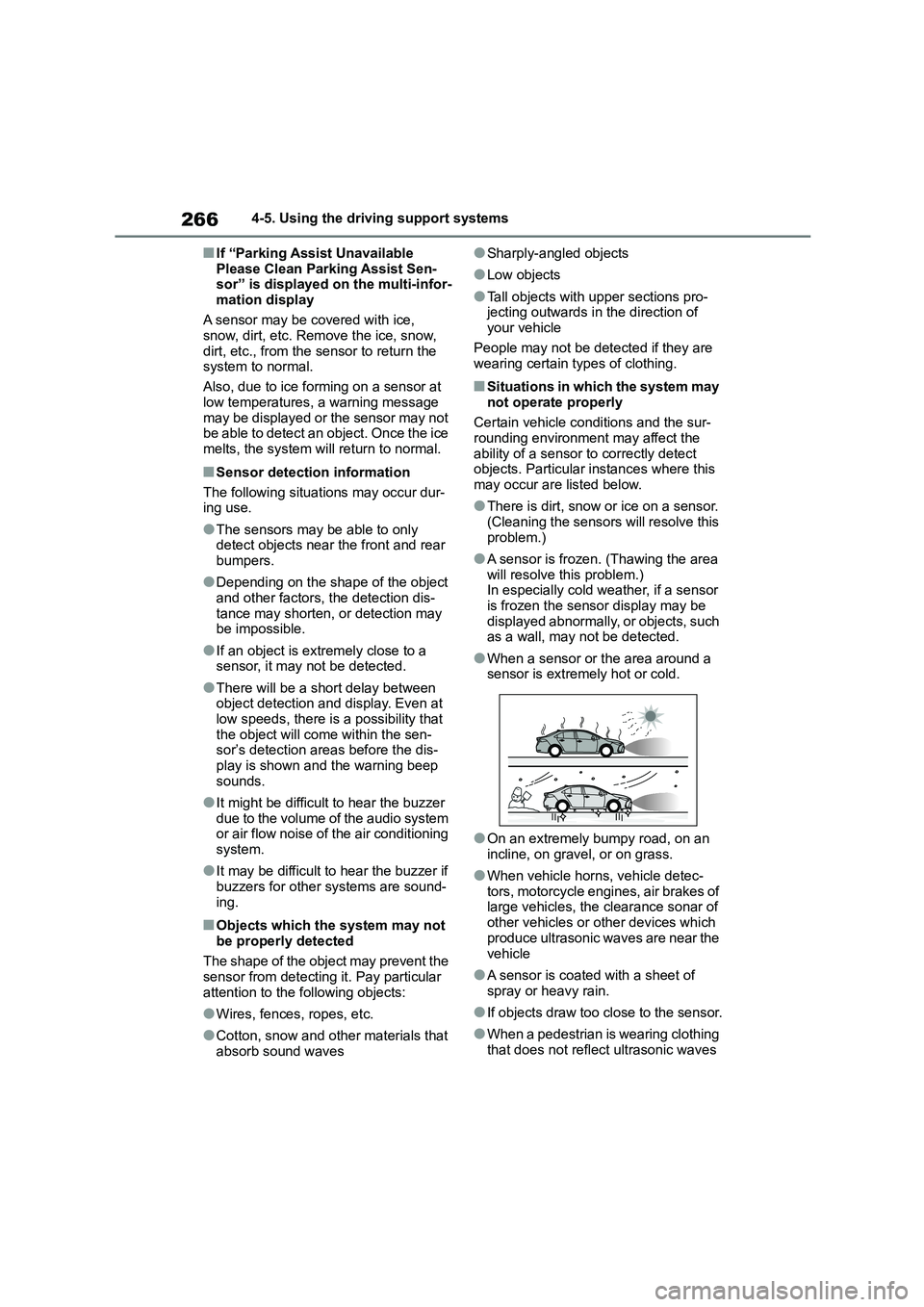
2664-5. Using the driving support systems
■If “Parking Assist Unavailable
Please Clean Parking Assist Sen- sor” is displayed on the multi-infor-
mation display
A sensor may be covered with ice, snow, dirt, etc. Remove the ice, snow,
dirt, etc., from the sensor to return the
system to normal.
Also, due to ice forming on a sensor at
low temperatures, a warning message
may be displayed or the sensor may not be able to detect an object. Once the ice
melts, the system will return to normal.
■Sensor detection information
The following situations may occur dur- ing use.
●The sensors may be able to only detect objects near the front and rear
bumpers.
●Depending on the shape of the object
and other factors, the detection dis-
tance may shorten, or detection may be impossible.
●If an object is extremely close to a sensor, it may not be detected.
●There will be a short delay between object detection and display. Even at
low speeds, there is a possibility that
the object will come within the sen- sor’s detection areas before the dis-
play is shown and the warning beep
sounds.
●It might be difficult to hear the buzzer
due to the volume of the audio system or air flow noise of the air conditioning
system.
●It may be difficult to hear the buzzer if
buzzers for other systems are sound-
ing.
■Objects which the system may not
be properly detected
The shape of the object may prevent the
sensor from detecting it. Pay particular
attention to the following objects:
●Wires, fences, ropes, etc.
●Cotton, snow and other materials that
absorb sound waves
●Sharply-angled objects
●Low objects
●Tall objects with upper sections pro- jecting outwards in the direction of
your vehicle
People may not be detected if they are wearing certain types of clothing.
■Situations in which the system may
not operate properly
Certain vehicle conditions and the sur- rounding environment may affect the
ability of a sensor to correctly detect
objects. Particular instances where this may occur are listed below.
●There is dirt, snow or ice on a sensor. (Cleaning the sensors will resolve this
problem.)
●A sensor is frozen. (Thawing the area
will resolve this problem.)
In especially cold weather, if a sensor is frozen the sensor display may be
displayed abnormally, or objects, such
as a wall, may not be detected.
●When a sensor or the area around a
sensor is extremely hot or cold.
●On an extremely bumpy road, on an
incline, on gravel, or on grass.
●When vehicle horns, vehicle detec-
tors, motorcycle engines, air brakes of large vehicles, the clearance sonar of
other vehicles or other devices which
produce ultrasonic waves are near the
vehicle
●A sensor is coated with a sheet of
spray or heavy rain.
●If objects draw too close to the sensor.
●When a pedestrian is wearing clothing
that does not reflect ultrasonic waves
Page 269 of 678
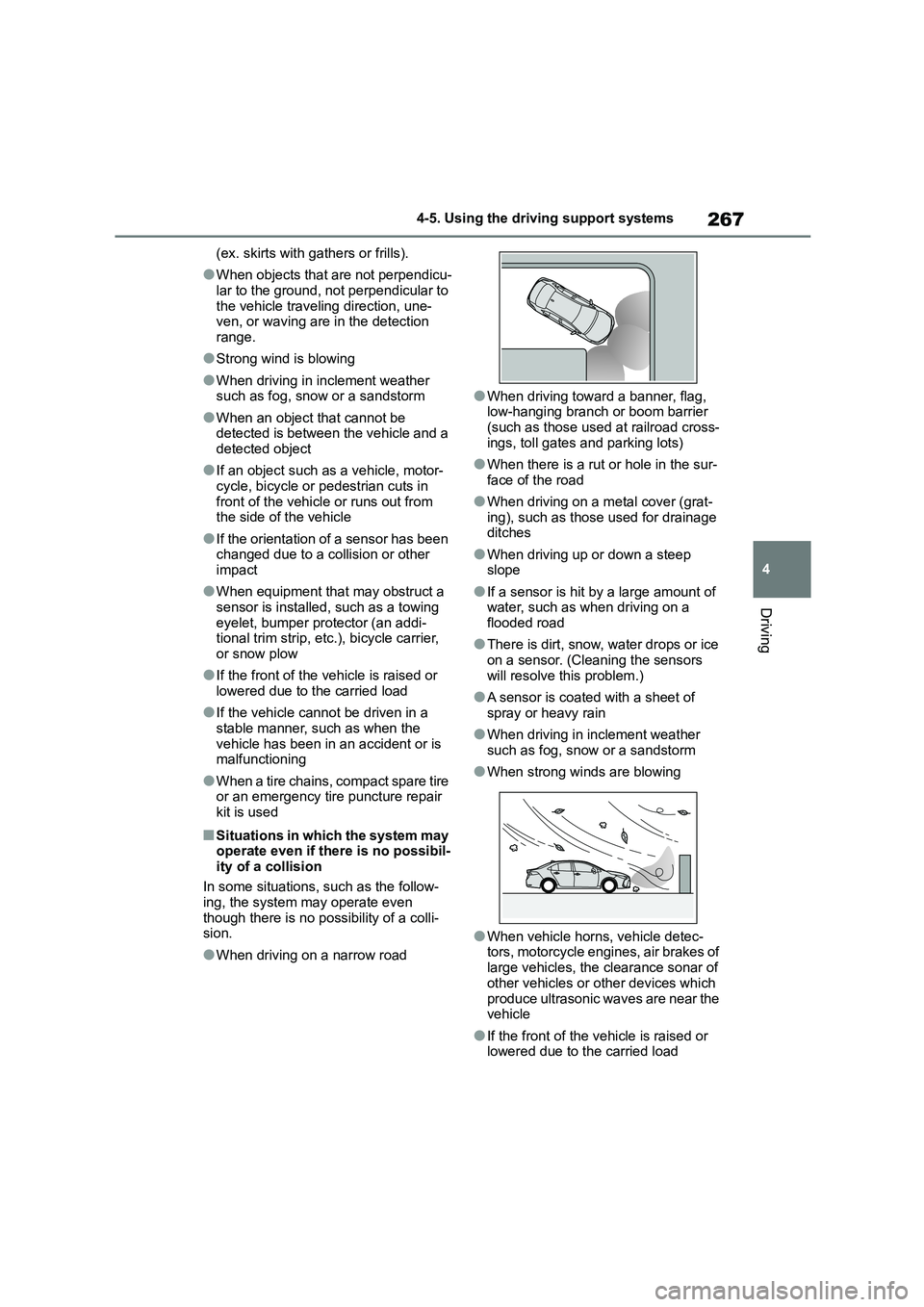
267
4
4-5. Using the driving support systems
Driving
(ex. skirts with gathers or frills).
●When objects that are not perpendicu-
lar to the ground, not perpendicular to
the vehicle traveling direction, une- ven, or waving are in the detection
range.
●Strong wind is blowing
●When driving in inclement weather such as fog, snow or a sandstorm
●When an object that cannot be detected is between the vehicle and a
detected object
●If an object such as a vehicle, motor-
cycle, bicycle or pedestrian cuts in
front of the vehicle or runs out from the side of the vehicle
●If the orientation of a sensor has been changed due to a collision or other
impact
●When equipment that may obstruct a
sensor is installed, such as a towing
eyelet, bumper protector (an addi- tional trim strip, et c.), bicycle carrier,
or snow plow
●If the front of the vehicle is raised or
lowered due to the carried load
●If the vehicle cannot be driven in a
stable manner, such as when the
vehicle has been in an accident or is malfunctioning
●When a tire chains, compact spare tire or an emergency tire puncture repair
kit is used
■Situations in which the system may
operate even if there is no possibil- ity of a collision
In some situations, such as the follow-
ing, the system may operate even
though there is no possibility of a colli- sion.
●When driving on a narrow road
●When driving toward a banner, flag,
low-hanging branch or boom barrier (such as those used at railroad cross-
ings, toll gates and parking lots)
●When there is a rut or hole in the sur-
face of the road
●When driving on a metal cover (grat-
ing), such as those used for drainage
ditches
●When driving up or down a steep
slope
●If a sensor is hit by a large amount of
water, such as when driving on a flooded road
●There is dirt, snow, water drops or ice on a sensor. (Cleaning the sensors
will resolve this problem.)
●A sensor is coated with a sheet of
spray or heavy rain
●When driving in inclement weather
such as fog, snow or a sandstorm
●When strong winds are blowing
●When vehicle horns, vehicle detec- tors, motorcycle engines, air brakes of
large vehicles, the clearance sonar of
other vehicles or other devices which
produce ultrasonic waves are near the vehicle
●If the front of the vehicle is raised or lowered due to the carried load
Page 270 of 678

2684-5. Using the driving support systems
●If the orientation of a sensor has been
changed due to a collision or other impact
●The vehicle is approaching a tall or curved curb
●Driving close to columns (H-shaped steel beams, etc.) in multi-story park-
ing garages, construction sites, etc.
●If the vehicle cannot be driven in a
stable manner, such as when the
vehicle has been in an accident or is malfunctioning
●On an extremely bumpy road, on an incline, on gravel, or on grass
●When a tire chains, compact spare tire or an emergency tire puncture repair
kit is used
■Detection range of the sensors
Approximately 100 cm (3.3 ft.)
Approximately 150 cm (4.9 ft.)
Approximately 60 cm (2.0 ft.)
Approximately 115 cm (3.8 ft.)
(vehicles with front side sensors
and rear side sensors)
The diagram shows the detection range
of the sensors. Note that the sensors
cannot detect objects that are
extremely close to the vehicle.
For details regarding object detection in
the side areas. ( P.265)
The range of the sensors may change
depending on the shape of the object,
etc.
■Multi-information display and head-up display (if equipped)
When an object is detected by a sens or, the approximate distance to the
object will be displayed on the multi- information display and head-up dis-
play (if equipped). (As the distance to the object becomes short, the dis-
tance segments may blink.)
The front side sensor displays and rear side sensor displays (if equipped)
Sensor detection display,
object distance
Page 271 of 678
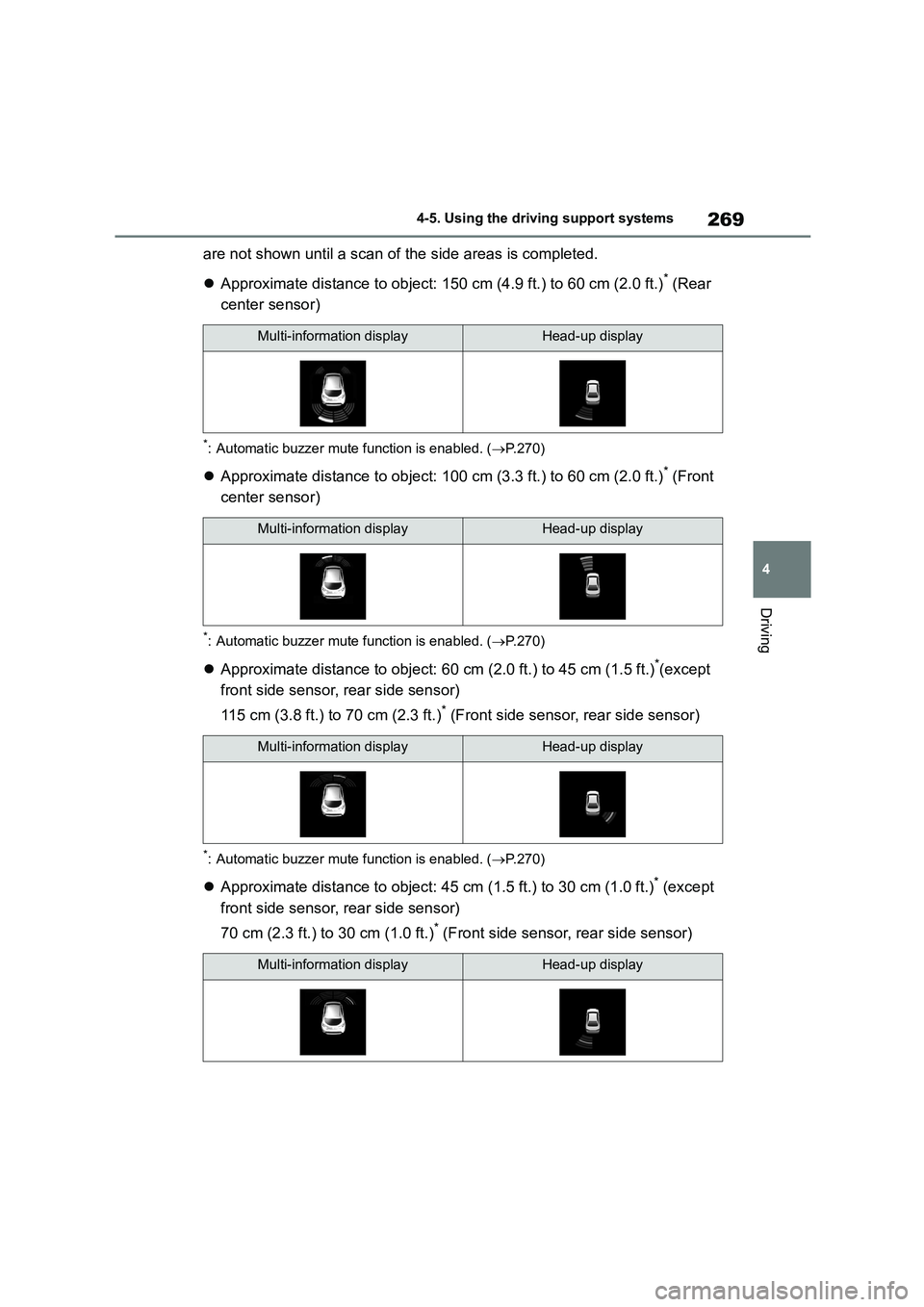
269
4
4-5. Using the driving support systems
Driving
are not shown until a scan of the side areas is completed.
Approximate distance to object: 150 cm (4.9 ft.) to 60 cm (2.0 ft.)* (Rear
center sensor)
*: Automatic buzzer mute function is enabled. ( P.270)
Approximate distance to object: 100 cm (3.3 ft.) to 60 cm (2.0 ft.)* (Front
center sensor)
*: Automatic buzzer mute function is enabled. ( P.270)
Approximate distance to object: 60 cm (2.0 ft.) to 45 cm (1.5 ft.)*(except
front side sensor, rear side sensor)
115 cm (3.8 ft.) to 70 cm (2.3 ft.)* (Front side sensor, rear side sensor)
*: Automatic buzzer mute function is enabled. ( P.270)
Approximate distance to object: 45 cm (1.5 ft.) to 30 cm (1.0 ft.)* (except
front side sensor, rear side sensor)
70 cm (2.3 ft.) to 30 cm (1.0 ft.)* (Front side sensor, rear side sensor)
Multi-information displayHead-up display
Multi-information displayHead-up display
Multi-information displayHead-up display
Multi-information displayHead-up display
Page 272 of 678
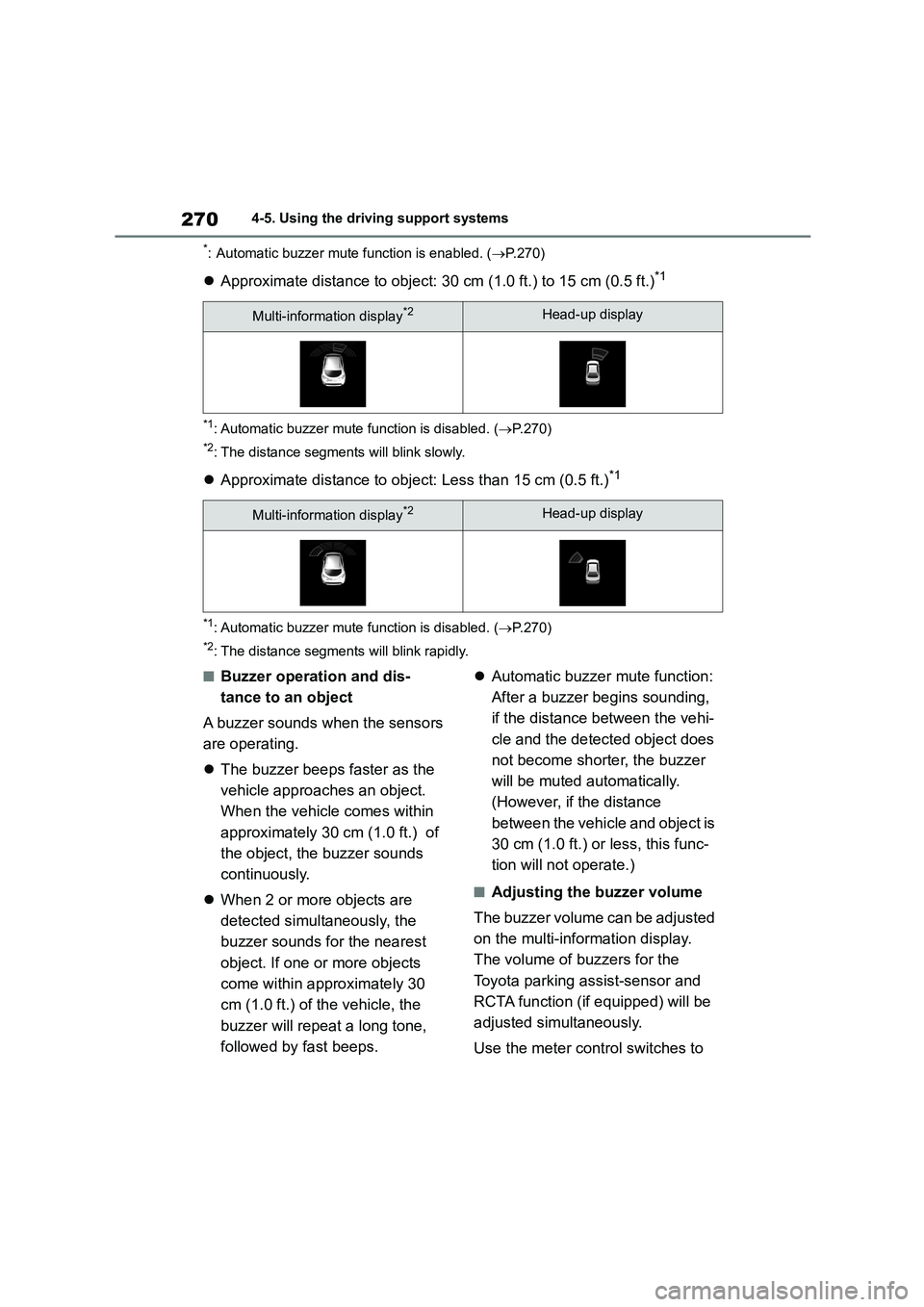
2704-5. Using the driving support systems
*: Automatic buzzer mute function is enabled. (P.270)
Approximate distance to object: 30 cm (1.0 ft.) to 15 cm (0.5 ft.)*1
*1: Automatic buzzer mute function is disabled. (P.270)
*2: The distance segments will blink slowly.
Approximate distance to object: Less than 15 cm (0.5 ft.)*1
*1: Automatic buzzer mute function is disabled. (P.270)
*2: The distance segments will blink rapidly.
■Buzzer operation and dis-
tance to an object
A buzzer sounds when the sensors
are operating.
The buzzer beeps faster as the
vehicle approaches an object.
When the vehicle comes within
approximately 30 cm (1.0 ft.) of
the object, the buzzer sounds
continuously.
When 2 or more objects are
detected simultaneously, the
buzzer sounds for the nearest
object. If one or more objects
come within approximately 30
cm (1.0 ft.) of the vehicle, the
buzzer will repeat a long tone,
followed by fast beeps.
Automatic buzzer mute function:
After a buzzer begins sounding,
if the distance between the vehi-
cle and the detected object does
not become shorter, the buzzer
will be muted automatically.
(However, if the distance
between the vehicle and object is
30 cm (1.0 ft.) or less, this func-
tion will not operate.)
■Adjusting the buzzer volume
The buzzer volume can be adjusted
on the multi-information display.
The volume of buzzers for the
Toyota parking assist-sensor and
RCTA function (if equipped) will be
adjusted simultaneously.
Use the meter control switches to
Multi-information display*2Head-up display
Multi-information display*2Head-up display
Page 273 of 678
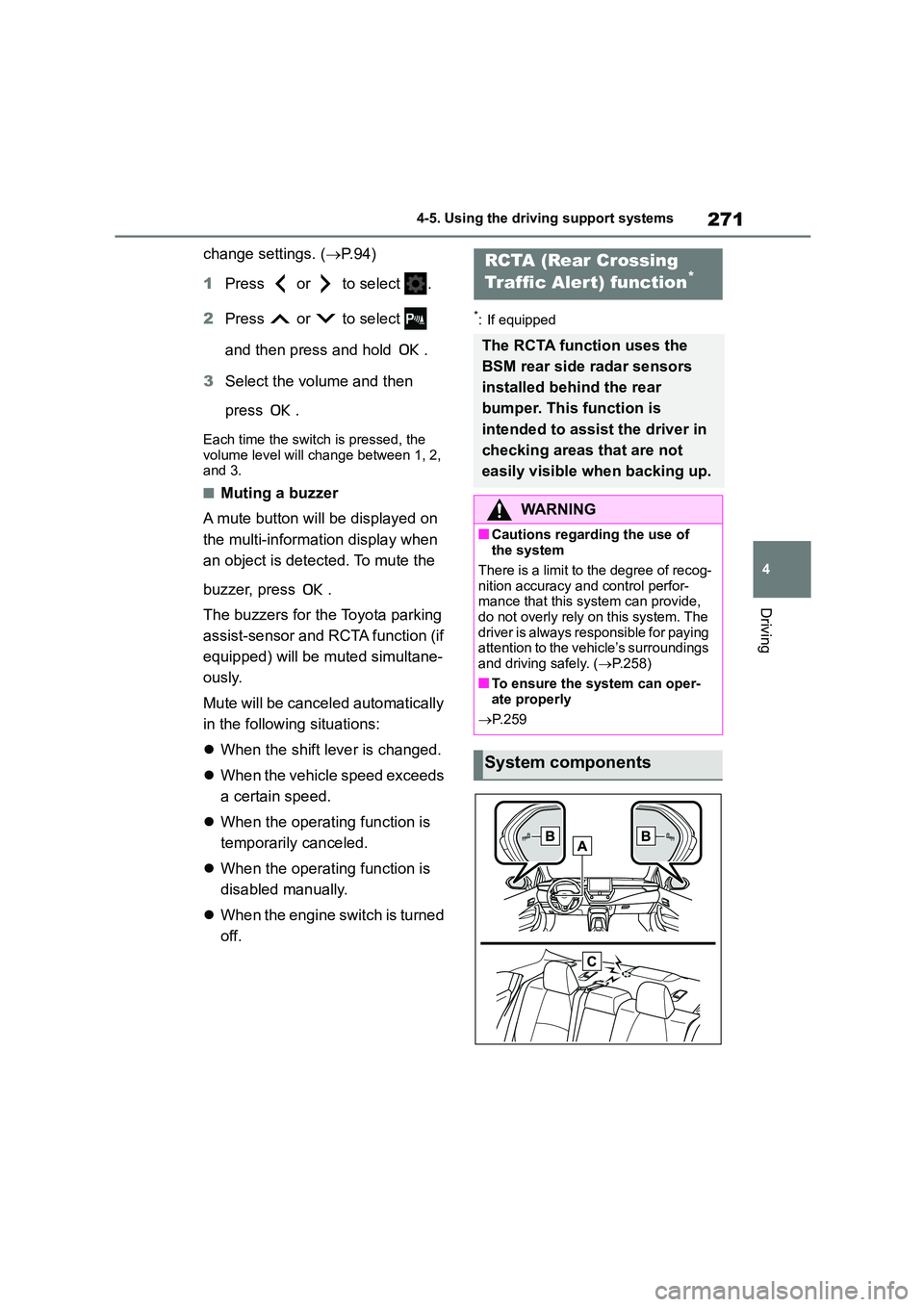
271
4
4-5. Using the driving support systems
Driving
change settings. ( P. 9 4 )
1 Press or to select .
2 Press or to select
and then press and hold .
3 Select the volume and then
press .
Each time the switch is pressed, the
volume level will change between 1, 2, and 3.
■Muting a buzzer
A mute button will be displayed on
the multi-information display when
an object is detected. To mute the
buzzer, press .
The buzzers for the Toyota parking
assist-sensor and RCTA function (if
equipped) will be muted simultane-
ously.
Mute will be cancel ed automatically
in the following situations:
When the shift lever is changed.
When the vehicle speed exceeds
a certain speed.
When the operating function is
temporarily canceled.
When the operating function is
disabled manually.
When the engine switch is turned
off.
*: If equipped
RCTA (Rear Crossing
Traffic Alert) function*
The RCTA function uses the
BSM rear side radar sensors
installed behind the rear
bumper. This function is
intended to assist the driver in
checking areas that are not
easily visible when backing up.
WA R N I N G
■Cautions regarding the use of the system
There is a limit to the degree of recog-
nition accuracy and control perfor- mance that this system can provide,
do not overly rely on this system. The
driver is always responsible for paying attention to the vehicle’s surroundings
and driving safely. ( P.258)
■To ensure the system can oper- ate properly
P. 2 5 9
System components